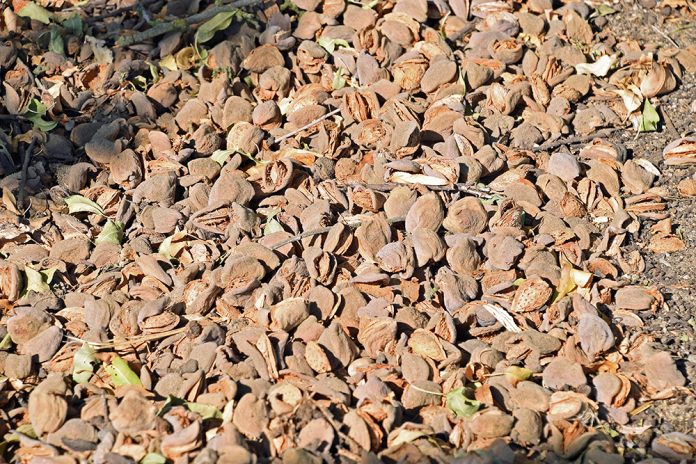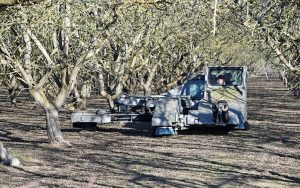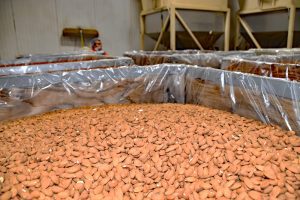
Much like teachers hand out report cards at the end of the school year, almond handlers share grade sheets with growers after harvest showing where they may need to improve pest programs. Even before the nuts make it to handlers, sampling shaken nuts on the orchard floor can give a broad picture of pest issues.
Although growers and their PCAs can’t go back and fix problems encountered the past season, they can use the information to address potential pest issues moving forward. And depending on the grades, growers may have left money on the table.
“A lot of growers think it’s all about pounds, but quality is what sells,” said Mel Machado, vice president of member relations for Blue Diamond Growers in Salida, California. “Quality is what matters to the seller and the buyer. In the almond world, you can earn more money per pound if you put out a better-quality product.”
Franz Niederholzer, UCCE orchard systems farm advisor for Colusa, Sutter and Yuba counties, agreed. “You can’t do much about yield because it’s often largely based on bloom and bee flying weather, and you can’t do much about the overall market price, but you can pay attention to quality. If you’re looking at 1% to 3% damage from ants, you can do the math on the cost of that loss relative to the inexpensive cost of ant bait and application. It’s a place you can really improve your bottom line. The goal is maximizing net grower return per acre.”
Through the federal almond marketing order, the industry has established 11 grades (seven for meats and four for in-shell product) with corresponding quality standards. USDA Shipping Point Inspection personnel grade samples from each load at each handler and report the results.
As an incentive to produce top-quality nuts, Blue Diamond offers quality meat and quality in-shell programs that reward grower-members for zero to very low levels of foreign material and rejects. For meat deliveries, the cooperative also considers levels of chipped and broken kernels and in-shell, which is the amount of in-shell product in the meats. For in-shell deliveries, Blue Diamond also factors loose meats into its quality schedule.
-op’s standards for its highest meat and in-shell quality designations are significantly higher than those for USDA’s top U.S. Fancy and U.S. No. 1 grades, respectively.
In years with low to medium prices, Machado said quality premiums become more important because they’re a larger proportion of the overall grower price.

First Identify the Issue
Huron-based Woolf Farming Co. partners with Harris Woolf California Almond in Coalinga for hulling, shelling and processing.
Matt Toste, Woolf Farming Co. farm manager for almond orchards in Merced County and north, said when he receives USDA grade reports, he first scans moisture levels. The USDA allows 5%, and Toste said they try to maximize harvest efficiencies.
Chip & scratch, dissimilar, doubles and split and broken typically aren’t issues, either. But what he keys in on is the portion of inedible kernels compared to edible.
When he first started at Woolf Farming, he said they averaged 1.5% to 2%. Now if anything comes in over 1% inedible, he asks for USDA inspector sheets, which break down the causes.
“Those really give you the detail of what the insects were, whether they were pinhole, worms or some sort of ants,” Toste said.
He provided an example of a load that had 45.5 grams of inedible kernels from a 2,000-gram (4.4 pounds) sample. The inedible portion was more than 2.2%.
“We wanted to know what was causing this, so we got the inspector’s report,” Toste said. “Our worm was only 2 grams, or one nut. But we had 31.5 grams of brown spot. Leaf-footed plant bugs and some of the other true bugs cause brown spot when they penetrate the kernel later in the season. Actually, our NOW (navel orangeworm) problem has been OK, and we need to keep up on that program, but we also need to look after whatever bug is bothering us.”
Without pinpointing the root of their problems, Toste said their pest management program could be wasting time and money.
“If we’re sitting here focused on NOW but our problem is actually brown spot or ants, we’re putting our efforts in the wrong spot,” he said.

Know Thy Enemy
At Blue Diamond, growers can ask to have a sample broken down for reject causes. Although the percentage of growers who request the optional service is small, Machado said it is increasing. The breakdown report lists the proportion by percentage of each type of foreign material, such as the hull portion of sticktights. It also lists the proportion by percentage of rejects, such as mold, ants, NOW and brown spot.
If a grower is sending in 10 loads, he recommended sampling two that are representative. If there are problem portions of an orchard, he recommended having a representative sample taken from that area, too. In addition, growers with neighbors who don’t use good sanitation or pest control measures may want to have samples pulled to document the problem.
By asking for the breakdown, Machado said growers can focus their pest control efforts during the upcoming season.
“Let’s say you’re treating for NOW because historically NOW has been a problem, but you have stink bugs and ants,” Machado said. “You’re spending money in the wrong area. How do you control something when you don’t know what it is?
“If the foundation of NOW management is sanitation, the foundation of reject management is to know what the heck you have. You wouldn’t take a shotgun to hunt a deer.”
Machado said some may argue about the importance of chipped and broken, but he considers them a pet peeve that can be greatly reduced by proper irrigation and timely harvests. For example, if you shake almonds too green before the skin has set, it may sluff during shelling and cause “peelers.” With the skin removed, Blue Diamond considers them equivalent to chipped & broken. For its top-quality Q+ Nonpareil meat designation, the co-op has set a chipped & broken threshold of 2% or less.

Post-Shake Sampling
Machado said he agreed with USDA-ARS Entomologist Joel Siegel, who recommended doubling the reject number on grade sheets to get a more realistic picture of orchard pest issues.
“Depending on what the reject is, some will be blown out in the harvest, and the huller and sheller also will clean that stuff up,” Machado said. “Gravity decks, and if they have color sorters, they’re going to take more of that out.”
To obtain a more realistic picture of nut damage, UCCE recommends collecting a 500-nut sample after shaking and before sweeping in each orchard. Collect nuts from multiple areas of the block and not just the top layer of the rows; in other words, make it representative.
Crack them out and record pest issues. If the nuts can’t be cracked immediately, freeze them for later inspection.
Niederholzer said most of the experienced PCAs he knows collect post-shake samples to look for signs of pests. For growers who don’t want to take the time or don’t have the time to crack nut samples, a number of companies, such as Integral Ag in Chico, will do it for you and provide detailed results for a fee.
Niederholzer compared post-shake sampling and postharvest grade reports to leaf analysis for fertility programs. Without first knowing your nutrient levels, you can’t develop a cost-effective tree nutritional program. And the same holds true for pests.
“You have to know what your problems are first to really focus on developing an effective fix,” he said.
For more information on how to collect post-shaking samples as well as color images of pests and the related damage they cause, visit UC’s Sacramento Valley Orchard Source at
bit.ly/3J5Zlsb.

Vicky Boyd | Contributing Writer
A veteran agricultural journalist, Vicky Boyd has covered the industry in California, Florida, Texas, Colorado, the South and the Mid-South. Along the way, she has won several writing awards. Boyd attended Colorado State University, where she earned a technical journalism degree with minors in agriculture and natural resources. Boyd is known for taking complex technical or scientific material and translating it so readers can use it on their farms. Her favorite topics are entomology, weeds and new technology. When she’s not out “playing in the dirt,” as she calls agricultural reporting, Boyd enjoys running, hiking, knitting and sewing.















